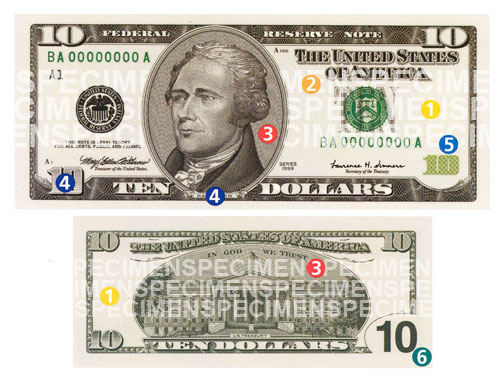|
|
 |
Content begins below
 |
|
 |
 $10 Bill (Series 1999, 2001, 2003): Features of the Series 1999-2003 $10 Bill $10 Bill (Series 1999, 2001, 2003): Features of the Series 1999-2003 $10 Bill
The United States of America is issuing currency with new features.
These features will help protect against technologies that could be used for counterfeiting. These $10 notes were first issued in Mid-2000. There will be no recall or devaluation of any U.S. currency. Old or new, all U.S. currency always will be honored at full face value.
Click here for information about the new currency designs.

- Watermark - A watermark of Hamilton is located in the blank space to the right of the portrait and is visible from both sides when held up to a light.
- Security Thread - The polymer thread, which glows orange when held under an ultraviolet light, is located to the right of the portrait. "USA TEN" and a flag can be seen from both sides of the note when held up to a bright light. The number "10" appears in the star field of the flag.
- Fine Line Printing Patterns - The fine lines printed behind Hamilton's portrait and the Treasury building are difficult to duplicate.
- Microprinting - Because they're so small, microprinted words are hard to replicate. On the front of the note, "TEN" is continually repeated in the numeral in the lower left-hand corner, and "The United States of America" is repeated just above Hamilton's name.
- Color-Shifting Ink - The number in the lower right corner on the front of the note looks green when viewed straight on, but appears black when viewed at an angle.
- Low-Vision Feature - The large numeral on the back of the $10 note is easy to read.
Also, a machine-readable feature has been incorporated for the blind. It will facilitate development of convenient scanning devices that could identify the note as a $10.
|
|

